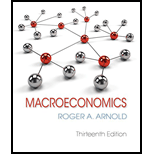
Macroeconomics
13th Edition
ISBN: 9781337617390
Author: Roger A. Arnold
Publisher: Cengage Learning
expand_more
expand_more
format_list_bulleted
Question
Chapter 19, Problem 1WNG
To determine
Expert Solution & Answer
Want to see the full answer?
Check out a sample textbook solution
Students have asked these similar questions
FAR LEFT
CANDIDATE
B
Candidate
A
-FAR RIGHT
Consider the race for governor of a small state. The population of the state is evenly divided between three cities-Riverville, Hanover, and Danbury.
The governor's race is between Ron Ruskin (the mayor of Riverville) and Ted Topple (the mayor of Hanover). Assume that no matter what is said
during the campaign, Ruskin can count on the support of 100% of the Riverville population, and Topple can count on the support of 100% of the
Hanover population. Assume 100% voter participation.
According to the result of majority-rule voting, the next governor will be the one preferred by the majority of the residents of
The two candidates are asked in a debate about their support of recreational subsidies. Public opinion polls in the city you just identified have shown
the following about the level of recreational subsidies desired:
• 70% want a low level
20% want a medium level
• 10% want a high level
Assuming that voters prefer outcomes closer to their preferred choices to outcomes further away,…
Assume there are three voters: A, B and C. Voter preferences can be ranked along a left-to-right spectrum that ranges from 1-9; 1 being the most left leaning preference and 9 being the most right leaning preference. Suppose these voters will choose between candidates Smith and Jones in an upcoming election. Assuming the following voter preferences:
True/False Explain: If the median voter theorem holds, candidates Smith and Jones will either both adopt preference 5 OR one will adopt preference 4 while the other adopts preference 6.
B. Suppose the electorate becomes more polarized; A moves from 4 to 1 while C moves from 6 to 9. B remains at 4. How does the median voter model predict candidates Smith and Jones will change their preference?
C. Keeping the assumptions from B, how does the election result change if a tax on non-voters doubles the number of voters while preserving the distribution of preferences?
D. If the tax in C induces 100% compliance (everyone votes), did this tax…
Knowledge Booster
Similar questions
- In a congressional district somewhere in the U.S., a new representative is being elected. The voters all have one-dimensional political views that can be neatly arrayed on a left-right spectrum. We can define the ”location” of a citizen’s political views in the following way. The citizen with the most extreme left-wing views is said to be at point 0 and the citizen with the most extreme right-wing views is said to be at point 1. If a citizen has views that are to the right of the views of the fraction x of the state’s population, that citizen’s views are said to be located at point x. There are two candidates for the congressional seat and they are forced to publicly state their own political position simultaneously on the zero-one left-right scale. 1.a Suppose voters always vote for the candidate whose stated position is nearest to their own views and suppose each candidate cares only about getting as many votes as possible. In equilibrium, what will be the two candidates’ positions?…arrow_forwardMatch the following according to the criterion. If a candidate receives [ Choose ] more than half the first- place votes in an election, then that candidate should be declared the winner. If a candidate is favored [ Choose ] when compared separately with every other candidate in an election, then that candidate should be declared the winner. If a candidate wins an [ Choose] election and, in a reelection, the only changes are changes that favor the candidate, then that candidate should win the reelection. If a candidate wins an [ Choose ] election and, in a recount, the only changes are that one or more of the other candidates are removed from the ballot, then that candidate should still win the election.arrow_forwardPolitical Economy Assume there are three voters: A, B and C. Voter preferences can be ranked along a left-to-right spectrum that ranges from 1-9; 1 being the most left leaning preference and 9 being the most right leaning preference. Suppose these voters will choose between candidates Smith and Jones in an upcoming election. Voter Id Preference(1-9) A 4 B 5 C 6 True/False Explain: If the median voter theorem holds, candidates Smith and Jones will either both adopt preference 5 OR one will adopt preference 4 while the other adopts preference 6. Suppose the electorate becomes more polarized; A moves from 4 to 1 while C moves from 6 to 9. B remains at 5. How does the median voter model predict candidates Smith and Jones will change their preference? Keeping the assumptions from B, how does the election result change if a tax on non-voters doubles the number of voters while preserving the distribution of preferences? If the tax in C induces 100%…arrow_forward
arrow_back_ios
arrow_forward_ios
Recommended textbooks for you


 Economics (MindTap Course List)EconomicsISBN:9781337617383Author:Roger A. ArnoldPublisher:Cengage Learning
Economics (MindTap Course List)EconomicsISBN:9781337617383Author:Roger A. ArnoldPublisher:Cengage Learning Economics: Private and Public Choice (MindTap Cou...EconomicsISBN:9781305506725Author:James D. Gwartney, Richard L. Stroup, Russell S. Sobel, David A. MacphersonPublisher:Cengage Learning
Economics: Private and Public Choice (MindTap Cou...EconomicsISBN:9781305506725Author:James D. Gwartney, Richard L. Stroup, Russell S. Sobel, David A. MacphersonPublisher:Cengage Learning Microeconomics: Private and Public Choice (MindTa...EconomicsISBN:9781305506893Author:James D. Gwartney, Richard L. Stroup, Russell S. Sobel, David A. MacphersonPublisher:Cengage Learning
Microeconomics: Private and Public Choice (MindTa...EconomicsISBN:9781305506893Author:James D. Gwartney, Richard L. Stroup, Russell S. Sobel, David A. MacphersonPublisher:Cengage Learning



Economics (MindTap Course List)
Economics
ISBN:9781337617383
Author:Roger A. Arnold
Publisher:Cengage Learning


Economics: Private and Public Choice (MindTap Cou...
Economics
ISBN:9781305506725
Author:James D. Gwartney, Richard L. Stroup, Russell S. Sobel, David A. Macpherson
Publisher:Cengage Learning

Microeconomics: Private and Public Choice (MindTa...
Economics
ISBN:9781305506893
Author:James D. Gwartney, Richard L. Stroup, Russell S. Sobel, David A. Macpherson
Publisher:Cengage Learning